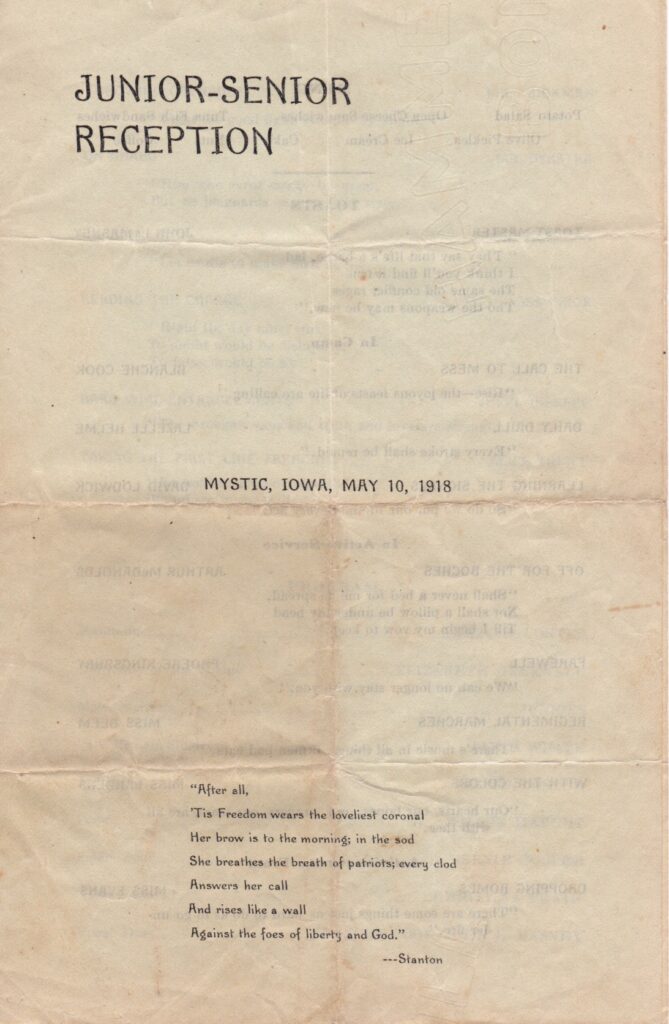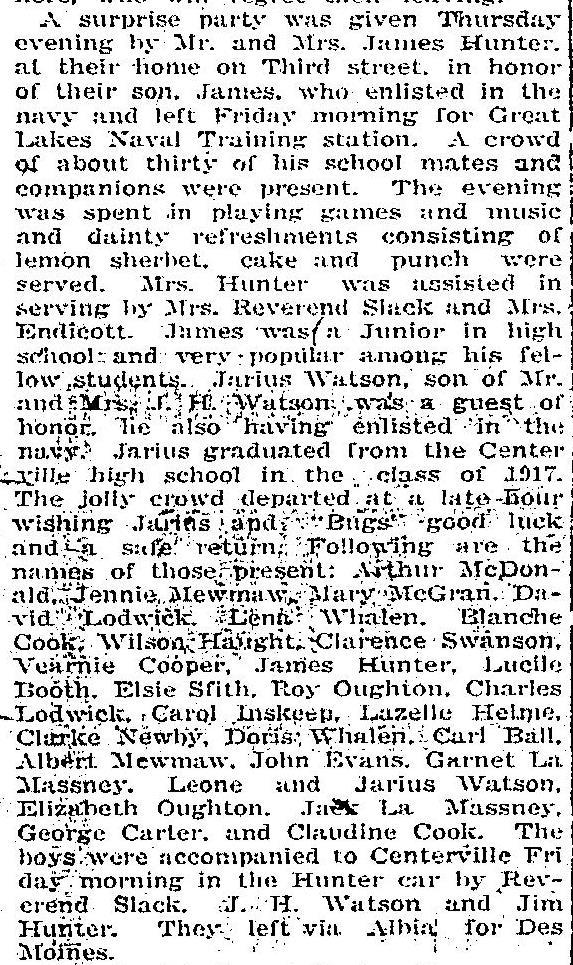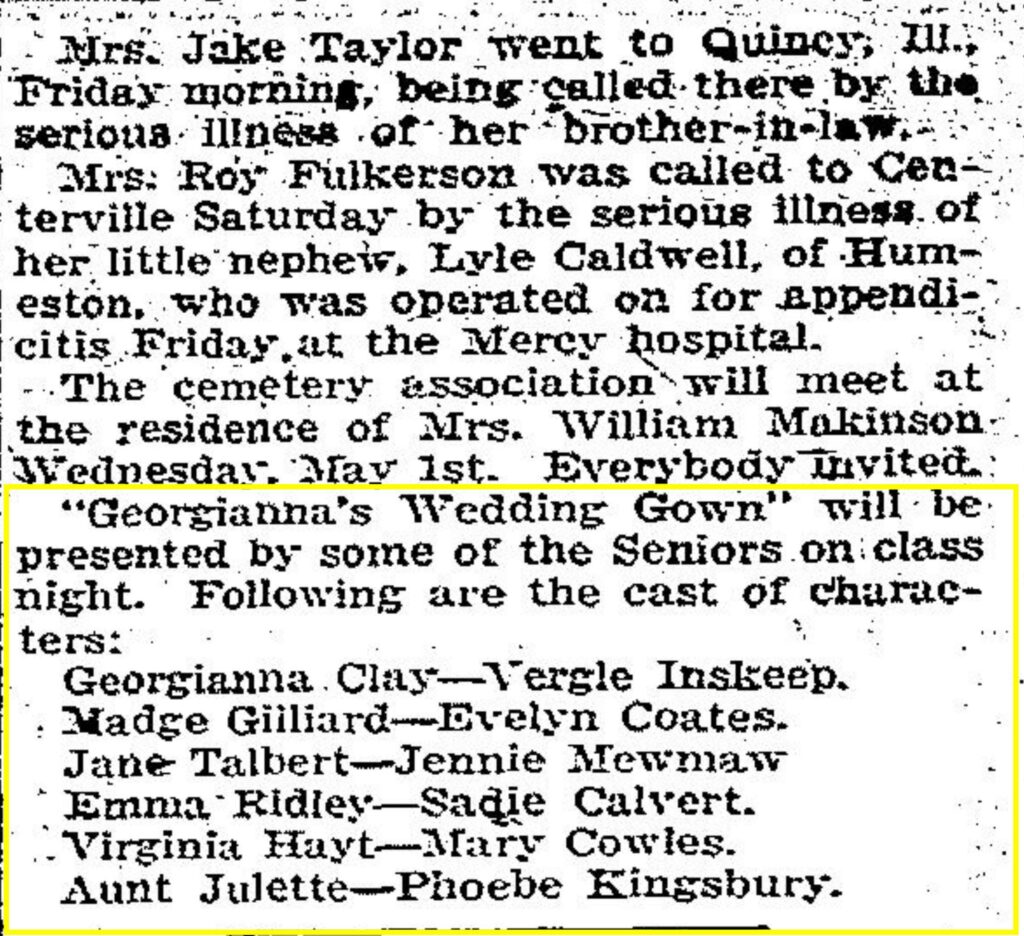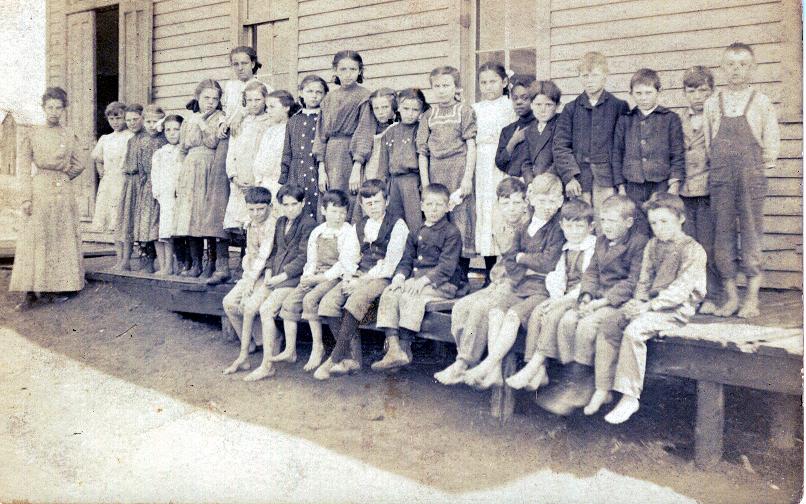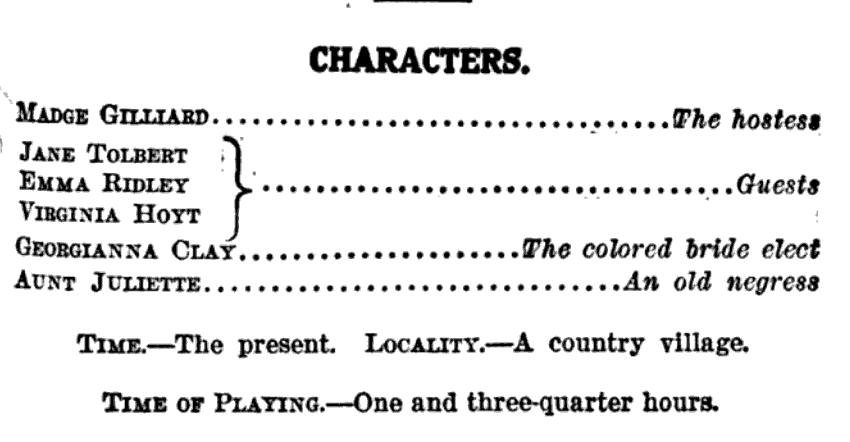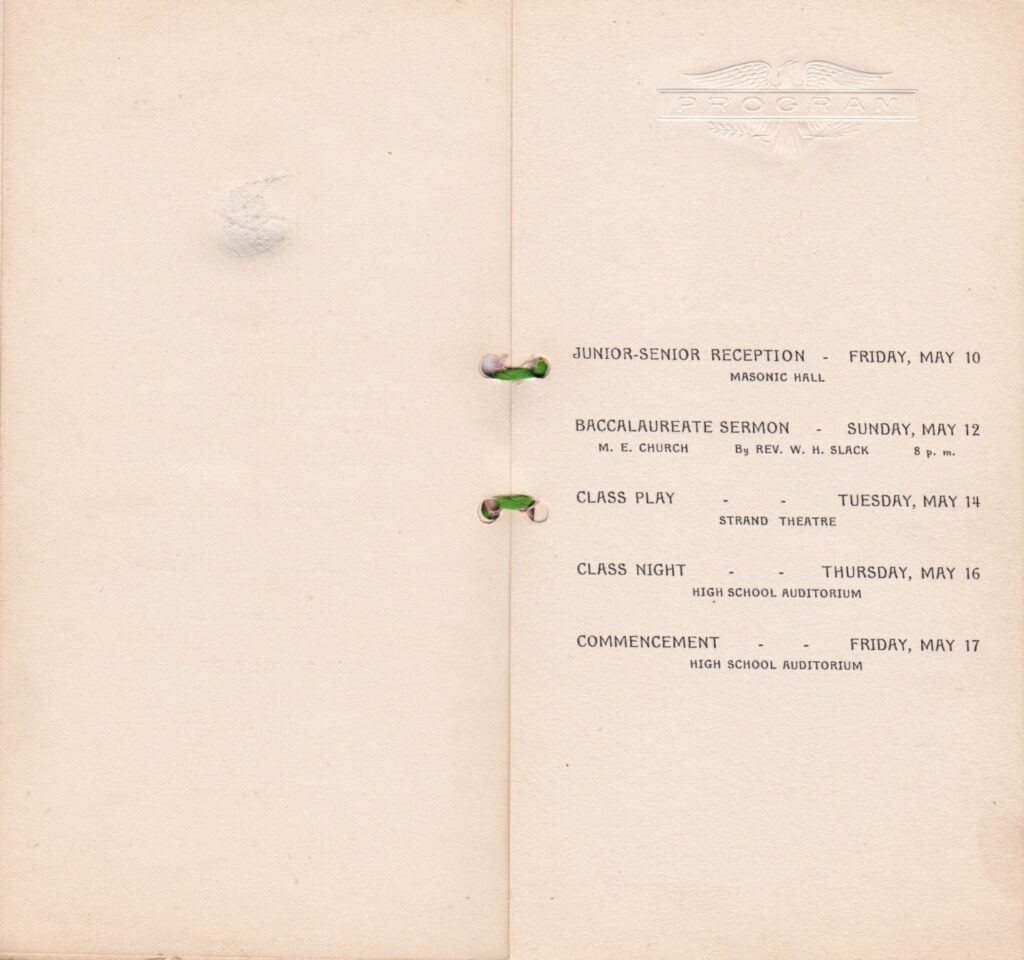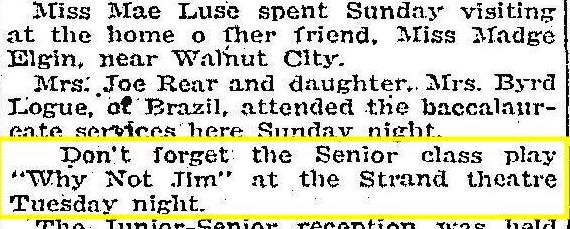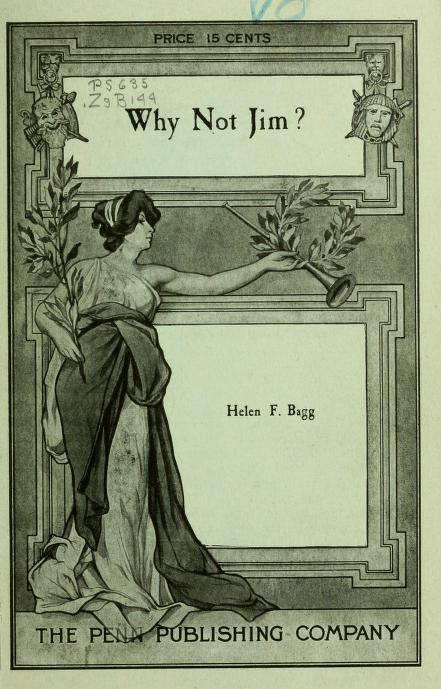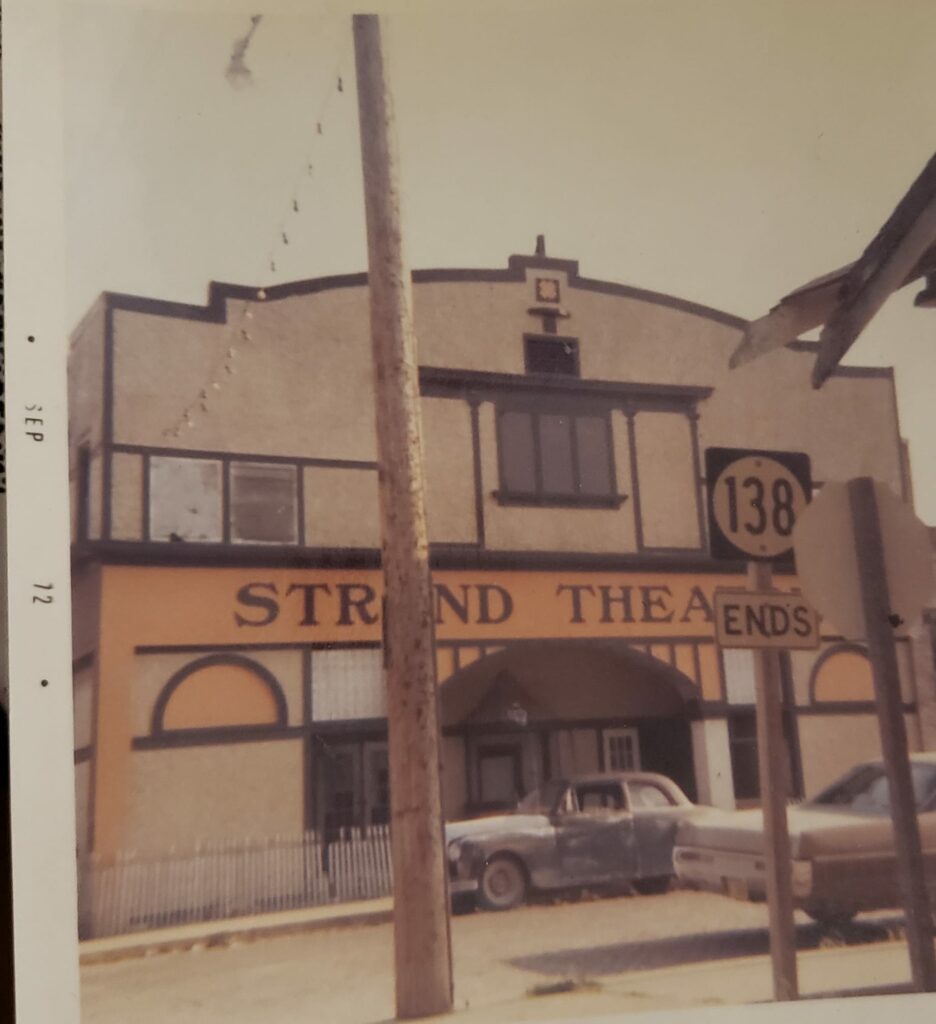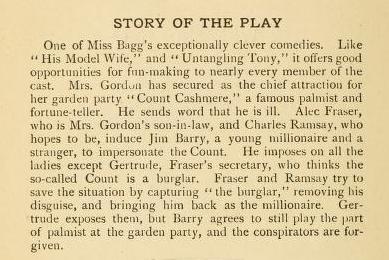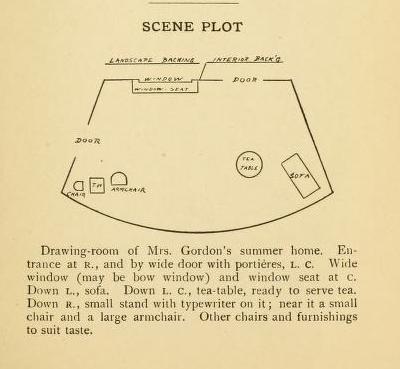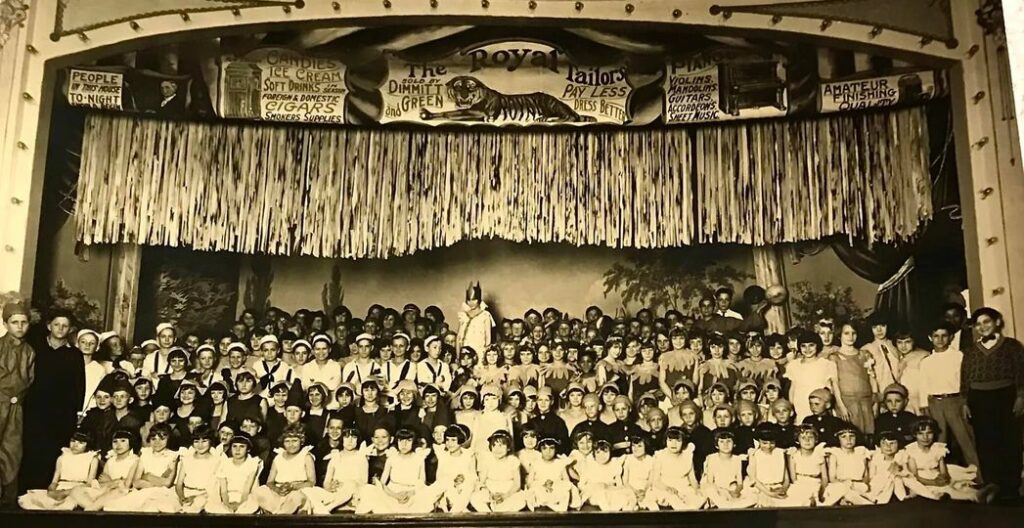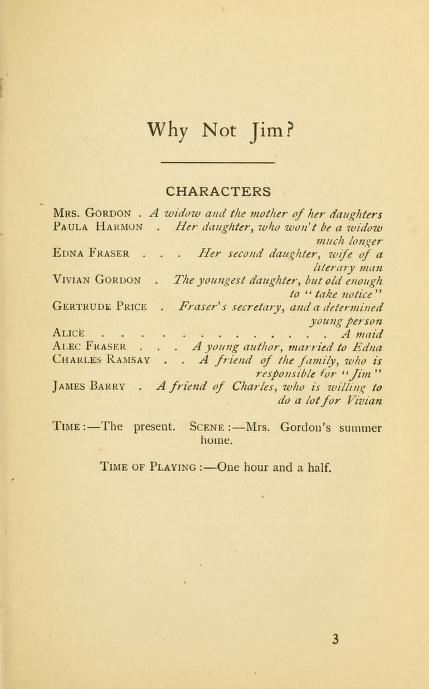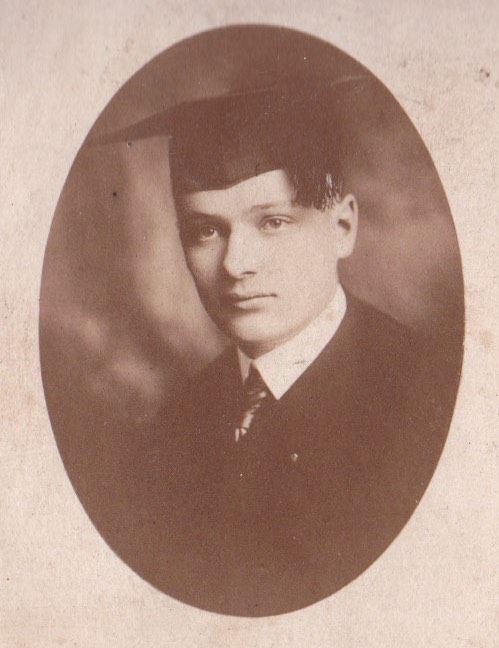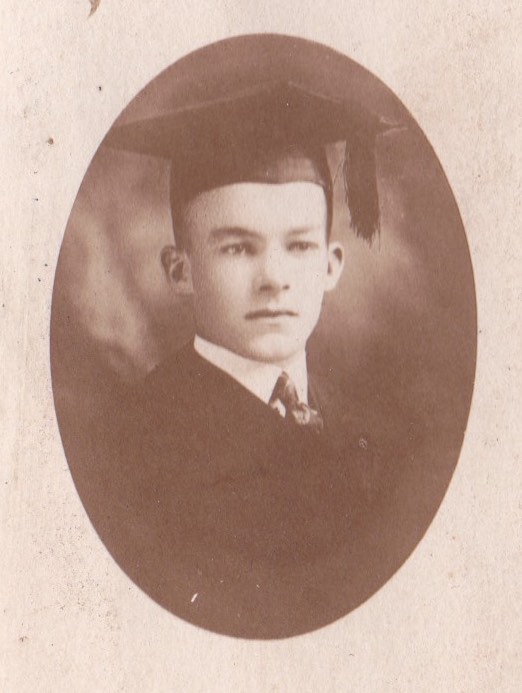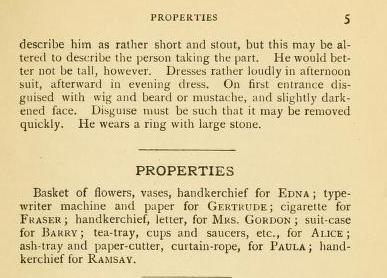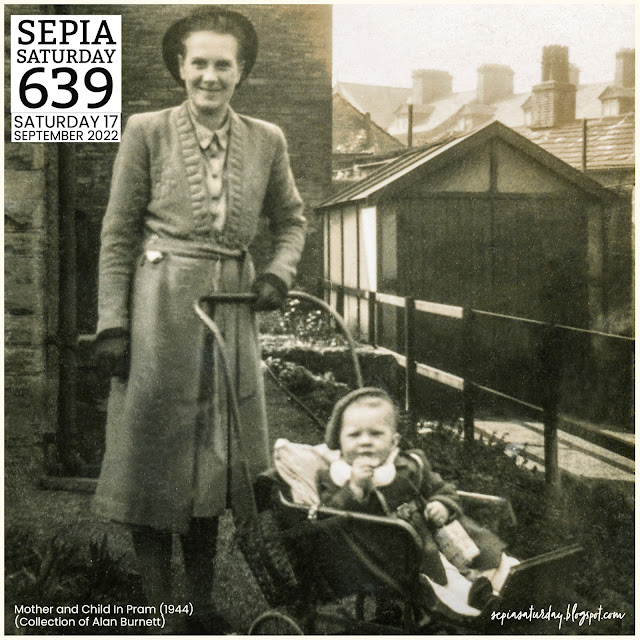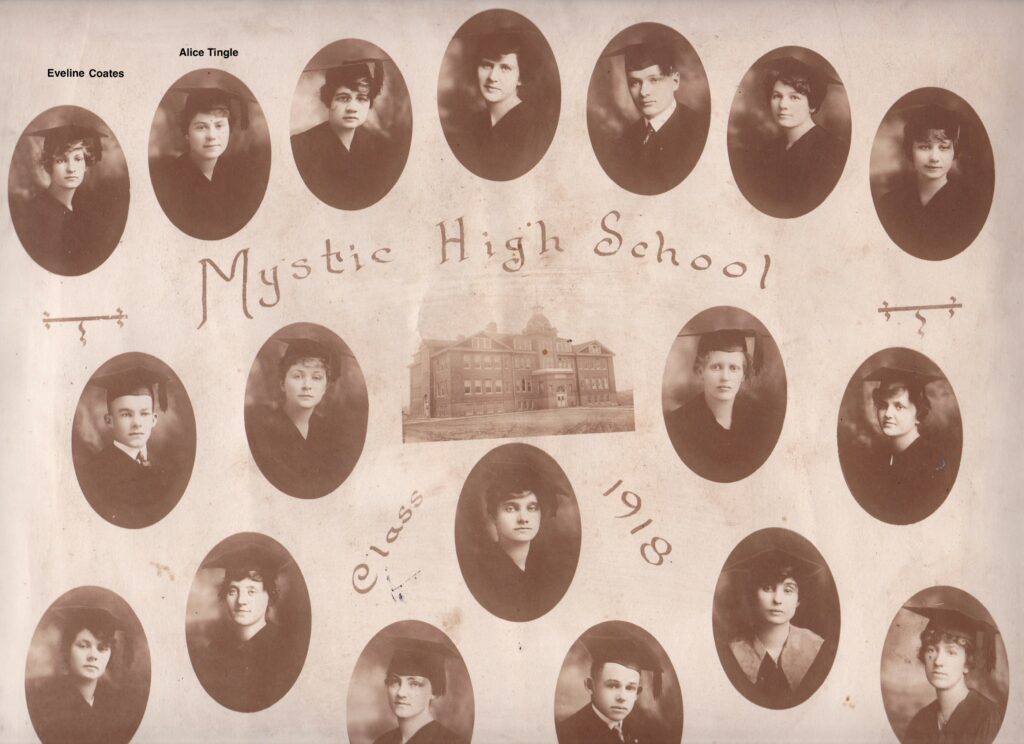
I shared a photo of my grandmother Eveline Coates’ high school graduating class in Mystic, Iowa a few weeks (now months!) ago. Along with the photo and her diploma, a couple of other mementos were saved. One is the program for the Junior-Senior Banquet in honor of the graduating Seniors. It was interesting to see how World War I seemed to be the overarching theme of the festivities. I decided to take a deeper look at what her life may have been like during the 1917-1918 school year. There was a lot going on, a war and the beginning of an influenza pandemic to name the two biggies. The list of related posts is getting long, so I’ll link them at the bottom.
At last I have arrived at the inspiration for this series – the program for the Junior-Senior Reception. I was struck by the theme of war in an event celebrating graduation from high school.
The newspaper write-up of the event offers a peek into the setting:
Sometimes I can’t help but giggle at typos – like “appropriated” names, “pickels,” and a three-piece orchestra that may have been on the menu. I was not familiar with the flower smilax and wondered if that was another typo. No, it was not.
Smilax is native to Iowa, and rarely spreads to the extent that it is weedy. However, since it is found on the edges of woods frequented by people, and often has thorns that get tangled in clothing or puncture skin, it is often considered undesirable. Also known as greenbriar, catbriar, and carrion flower (due to unpleasant odor of flowers).
https://crops.extension.iastate.edu/encyclopedia/smilax-greenbriar


Eveline and her classmates each received a pink rose from Faye Wilson, a former teacher and guest of honor. The decorations of white apple blossoms along side smilax, pink and green candles, and a canopy of paper ribbons must have created a lovely setting for the reception.
But …
… the cover of the program sets a different tone for the evening, highlighting the last stanza of the poem “One Country,” by Frank Lebby Stanton.
After all,
‘Tis Freedom wears the loveliest coronal
Her brow is the morning; in the sod
She breathes the breath of patriots; every clod
Answers her call
And rises like a wall
Against the foes of liberty and God.
The newspaper clipping continues:
There are three main headings in the schedule of events for the reception:
Menu, Toasts, and Program.
Under the heading of Toasts are the subheadings:
In Camp
In Active Service
Activities at the Front
… themes of war in juxtaposition to pink roses and a dainty luncheon menu.
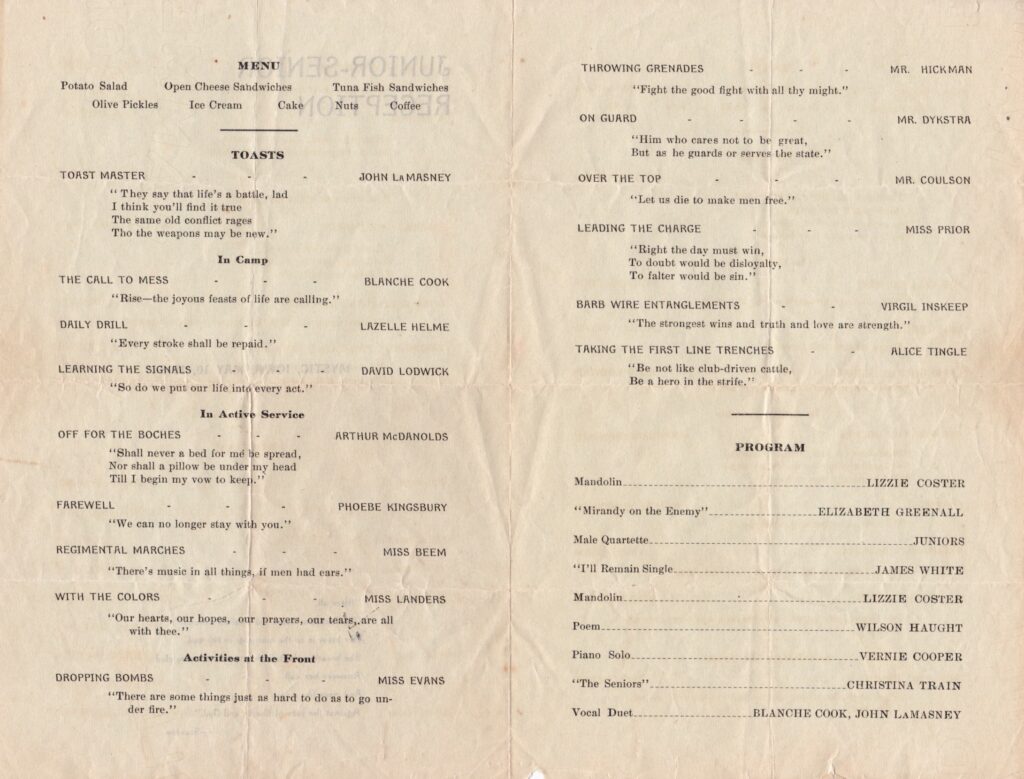
I don’t know if parents were invited to the reception, but members of the junior class, senior class, and teachers and school administrators were there. Possibly 40-45 people, not including parents. I’ve tried to imagine how the the evening progressed. I have no idea. Perhaps John LaMasney, as toastmaster, acted as emcee and introduced each of the other speakers. And what of the quotes in the program that accompanied the name of each individual? Did they serve as prompts for the toast that each would give? Perhaps some of the original sources were familiar to the students from their studies of poetry and literature. Who chose the the military phrases that framed the order of events? Who selected the quotes? Members of the Junior class? Teachers?
Since I’ve spent time researching the origins of the quotations, it would be a waste if I didn’t include them. I’ve linked to the sources where possible so you can read in full if you like.
A newspaper clipping from November of 1917 provides the names of Junior class members who attended a party at the home of Irene Lames. This was helpful to identify some of those who participated in the reception as members of the Junior class. However, just because someone attended a party for the juniors does not mean they were members of the junior class. Two of Eveline’s future sisters-in-law – my grandfather’s sisters, attended and, by my calculations, Ethel Hoskins would have been a junior, but not her older sister Edna.

Another clipping reveals how closely the Junior class experienced this time of war. Less than a month before the Junior-Senior Reception, many of them attended a surprise party for a classmate who was off to the Navy.
I just happened to stumble upon the clipping above when I searched for names of students who gave toasts at the reception. There may have been other students who had enlisted prior to the end of the school year. (They were not required to register for the draft at this age.) Of the eighteen graduating seniors, only three were male. In addition to the war, it was common in this community for boys to leave school before graduation and go to work, often in the coal mines.
John LaMasney, the toast master, was a member of the Junior class. The newspaper account of a sad accident in which one of John’s younger brothers died in November of 1918 reveals that the large LaMasney family operated a boarding house in Mystic.
The quote under the Toast Master section of the program is from the poem “The Man Behind the Gun,” by Alice Rolit Coe.
The first group of toasts fall under the heading: In Camp: The Call to Mess, Daily Drill, and Learning the Signals.
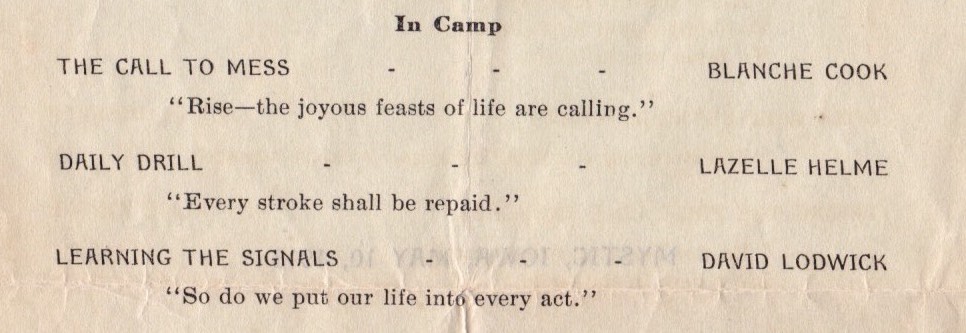
The Call to Mess – toast made by Blanche Cook, a Junior. She or her sister Claudine are noted as the authors of the “Late Happenings from Mystic” section of the Centerville Daily Iowegian and Citizen newspaper in a number of issues, so she must have kept up with all the news that was fit to print. This is one quote I wasn’t able to identify. If anyone knows, please share your knowledge!
Daily Drill – toast given by Lazelle Helme, a member of the Junior class. I found a lengthy article written by one of Lazelle’s friends about a road trip they made to Des Moines with a group. It provides some insight into the times as these high schoolers “motored” over Iowa roads and visited the cantonment outside Des Moines. Unfortunately, the copy of the second page of the newspaper article is quite poor. Lazelle was prompted by the words, “Every stroke shall be repaid,” a quote from Ralph Waldo Emerson’s essay On Compensation. I have not read the essay in its entirety, but others have said that Emerson is writing about the law of karma, about cause and effect, that bringing good into the world brings good into the world (or the opposite) because that is the nature of the world. (Extreme paraphrasing on my part.) The paragraph that contains the quote above follows:
The same guards which protect us from disaster, defect, and enmity, defend us, if we will, from selfishness and fraud. Bolts and bars are not the best of our institutions, nor is shrewdness in trade a mark of wisdom. Men suffer all their life long, under the foolish superstition that they can be cheated. But it is as impossible for a man to be cheated by any one but himself, as for a thing to be and not to be at the same time. There is a third silent party to all our bargains. The nature and soul of things takes on itself the guaranty of the fulfilment of every contract, so that honest service cannot come to loss. If you serve an ungrateful master, serve him the more. Put God in your debt. Every stroke shall be repaid. The longer the payment is withholden, the better for you; for compound interest on compound interest is the rate and usage of this exchequer.
Learning the Signals – toast given by David Lodwick. The program does not specify if this was the junior or elder. David Lodwick, Sr. was one of the partners in the Lodwick Brothers Coal Company. Two of Eveline’s brothers and possibly her father worked at the Diamond Block Mine #12, one of the mines owned by the Lodwicks. David Lodwick, Sr. was also president of the school board. David Lodwick, Jr. was a member of the Senior Class. My guess is that the toast was made by the president of the school board, simply because the program lists one boy and one girl in each section and the other toasts are made my teachers or school administrators. Again – just guessing.
The quote, “So do we put our life into every act” is also from the Emerson essay. It appears in the paragraph below:
The world globes itself in a drop of dew. The microscope cannot find the animalcule which is less perfect for being little. Eyes, ears, taste, smell, motion, resistance, appetite, and organs of reproduction that take hold on eternity, — all find room to consist in the small creature. So do we put our life into every act. The true doctrine of omnipresence is, that God reappears with all his parts in every moss and cobweb. The value of the universe contrives to throw itself into every point. If the good is there, so is the evil; if the affinity, so the repulsion; if the force, so the limitation.
https://archive.vcu.edu/english/engweb/transcendentalism/authors/emerson/essays/compensation.html
The next group of toasts fall under the category In Active Service: Off for the Boches, Farewell, Regimental Marches, and With the Colors.
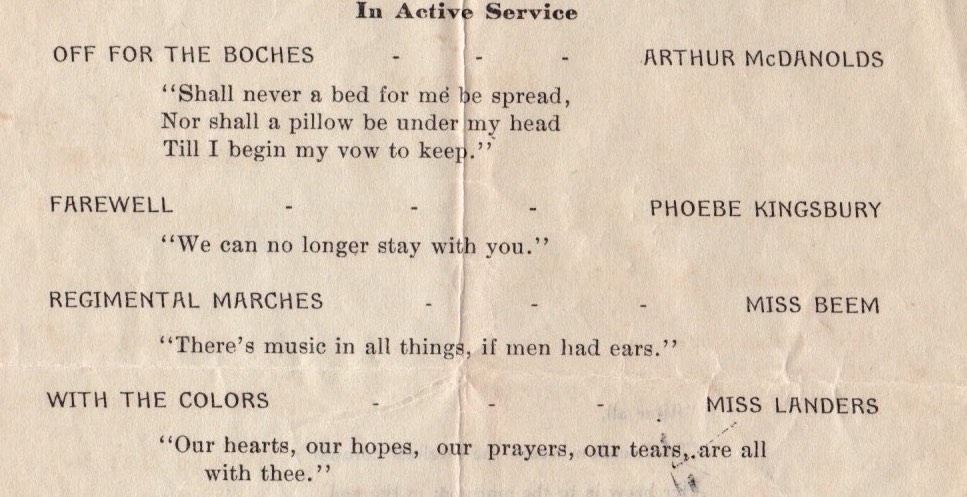
Off for the Boches – toast given by Arthur McDanolds, a senior. I was unfamiliar with the term “Boches” and had to look it up. Boche is a pejorative used to refer to Germans, particularly German soldiers. It is thought to have derived from a French slang word for head or cabbage – thus thick-headed or blockhead, slow, troublesome. I found quite a few French propaganda posters that used the term, not many American posters. This one harkens back to a previous post about food.
The quote to prompt Arthur McDanolds is from a poem by James Russell Lowell, “The Vision of Sir Launfal,” about a nobleman who goes on a quest to find the Holy Grail. The poem was first published in 1848 and was a popular school text, reprinted every year until after the turn of the century. The stanza which contains this quote:
“My golden spurs now bring to me,
The Vision of Sir Launfal
And bring to me my richest mail,
For to-morrow I go over land and sea
In search of the Holy Grail;
Shall never a bed for me be spread,
Nor shall a pillow be under my head,
Till I begin my vow to keep;
Here on the rushes will I sleep,
And perchance there may come a vision true
Ere day create the world anew.”
Slowly Sir Launfal’s eyes grew dim,
Slumber fell like a cloud on him,
And into his soul the vision flew.
by: James Russell Lowell
from: The Vision of Sir Launfal 1848
Farewell – toast by Phoebe Kingsbury, a senior. Does the quote “We can no longer stay with you” ring a bell with any of the musicians reading? With such solemn and philosophical sources for the other quotes, I found it amusing that these words come straight from the lyrics of There is a Tavern in the Town. According to Wikipedia, it is a traditional folk song first published the 1883 edition of William H. Hill’s Student Songs.
There is a tavern in the town, in the town
And there my true love sits him down, sits him down,
And drinks his wine as merry as can be,
And never, never thinks of me.
Chorus: Fare thee well, for I must leave thee,
Do not let this parting grieve thee,
And remember that the best of friends
Must part, must part.Adieu, adieu kind friends, adieu, adieu, adieu,
I can no longer stay with you, stay with you,
I will hang my harp on the weeping willow tree,
And may the world go well with thee.
He left me for a damsel dark, damsel dark,
Each Friday night they used to spark, used to spark,
And now my love who once was true to me
Takes this dark damsel on his knee.And now I see him nevermore, nevermore;
He never knocks upon my door, on my door;
Oh, woe is me; he pinned a little note,
And these were all the words he wrote:Oh, dig my grave both wide and deep, wide and deep;
https://en.wikipedia.org/wiki/There_Is_a_Tavern_in_the_Town
Put tombstones at my head and feet, head and feet
And on my breast you may carve a turtle dove,
To signify I died of love.
Regimental Marches – toast by Miss Beem. Esther Beem was the music teacher at Mystic High School, originally from the town of Chariton in Appanoose County. Finally! I found a photo of someone named here! Ancestry has the 1914 Chariton High School yearbook online. These words accompany her photo: “Her air, her manner, all who saw admired.”
A clipping from the local paper provides an account of an operetta performed by the high school glee clubs benefitting the work of the Junior Red Cross. I like finding more information about things I previously wrote about for this series!
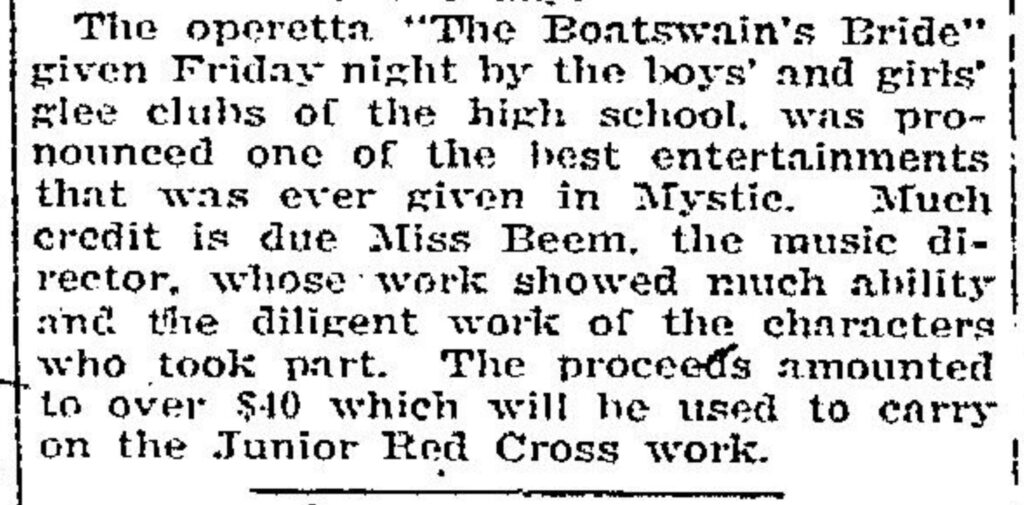
“There’s music in all things, if men had ears,” seems an appropriate prompt for a toast from the music teacher. It is a line from Don Juan: Canto The Fifteenth, by George Gordon Byron (Lord Byron), from the following stanza:
And as for love–O love!–We will proceed.
The Lady Adeline Amundeville,
A pretty name as one would wish to read,
Must perch harmonious on my tuneful quill.
There’s music in the sighing of a reed;
There’s music in the gushing of a rill;
There’s music in all things, if men had ears:
Their earth is but an echo of the spheres.
With the Colors – toast by Miss Landers. Mary Landers was the Domestic Science teacher at Mystic High School. I think I found a photo of Miss Landers in the 1909 Centerville High School yearbook available on ancestry.com
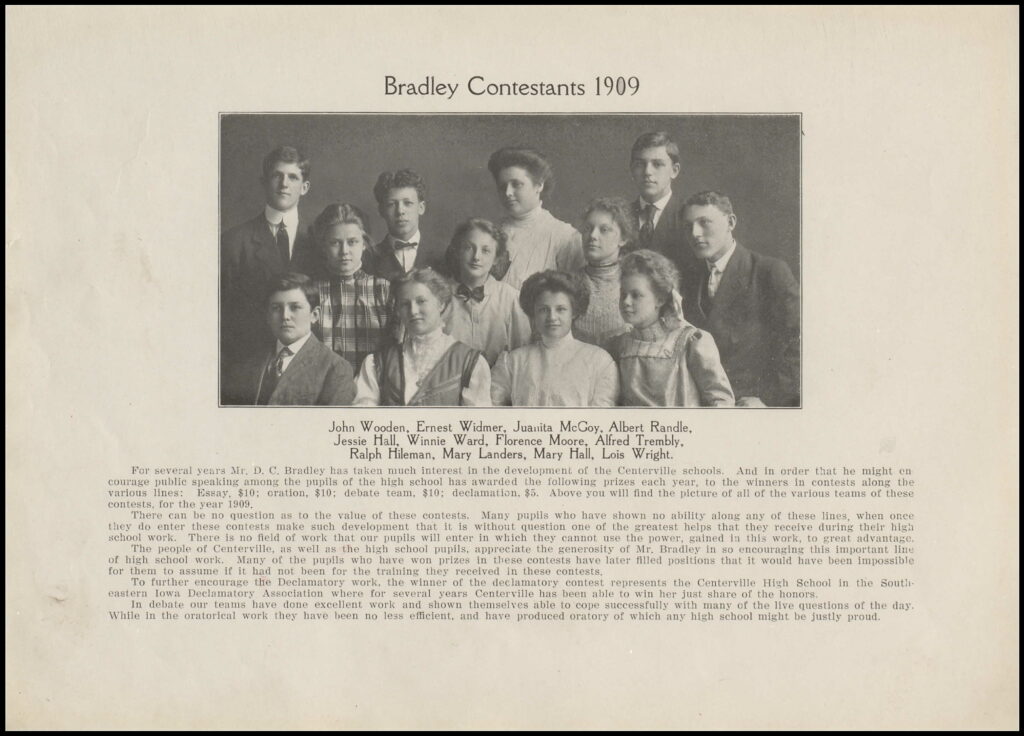
The local newspaper mentions Miss Landers on several occasions, preparing refreshments or meals for civic meetings.

Another clipping details a picnic with the Freshman class, providing a glimpse perhaps, of the relationship she had with her students. And another mention of the Junior Red Cross which I missed when researching earlier posts.

“Our hearts, our hopes, our prayers, our tears are all with thee,” is the toast prompt for Miss Landers. They are the last lines of the poem The Building of the Ship, by Henry Wadsworth Longfellow.
Thou, too, sail on, O Ship of State!
Sail on, O Union, strong and great!
Humanity with all its fears,
With all the hopes of future years,
Is hanging breathless on thy fate!
We know what Master laid thy keel,
What Workmen wrought thy ribs of steel,
Who made each mast, and sail, and rope,
What anvils rang, what hammers beat,
In what a forge and what a heat
Were shaped the anchors of thy hope!
Fear not each sudden sound and shock,
‘T is of the wave and not the rock;
‘T is but the flapping of the sail,
And not a rent made by the gale!
In spite of rock and tempest’s roar,
In spite of false lights on the shore,
Sail on, nor fear to breast the sea!
Our hearts, our hopes, are all with thee,
Our hearts, our hopes, our prayers, our tears,
Our faith triumphant o’er our fears,
Are all with thee, — are all with thee!
Since I have taken a lengthy and winding path through the program for the reception, I’m going to stop here and finish in another post. Otherwise, it may take me another month to finish this one!
This is my contribution to Sepia Saturday, where the photos of Miss Beem and Miss Landers, who are not mothers and daughters and are not wearing hats, are the closest I have come to matching the prompt photo. Please visit other responses to the prompt photo here: Sepia Saturday

If you would like to read other posts about Eveline’s Senior Year, you can find them here:
Eveline’s Senior Year, Part 1
Eveline’s Senior Year: The Draft and a Carnival
Eveline’s Senior Year: A Look Around Town
Eveline’s Senior Year: Musical Notes
Eveline’s Senior Year: Smallpox
Eveline’s Senior Year: What are you Serving?
Eveline’s Senior Year: Root Beer on the 4th
Eveline’s Senior Year: Miners, Miner and Maps
Eveline’s Senior Year: The Weight of Mining
Eveline’s Senior Year: Gatherings and Gossip
Eveline’s Senior Year: Knit Your Bit
Eveline’s Senior Year: In Search of a Back Story
Eveline’s Senior Year: Sign the Food Pledge
Eveline’s Senior Year: Produce, Preserve, Conserve
Eveline’s Senior Year: Graduation Memorabilia
Eveline’s Senior Year: Baccalaureate
Eveline’s Senior Year: Senior Class Play
Eveline’s Senior Year: Grandma was in a Play After All



